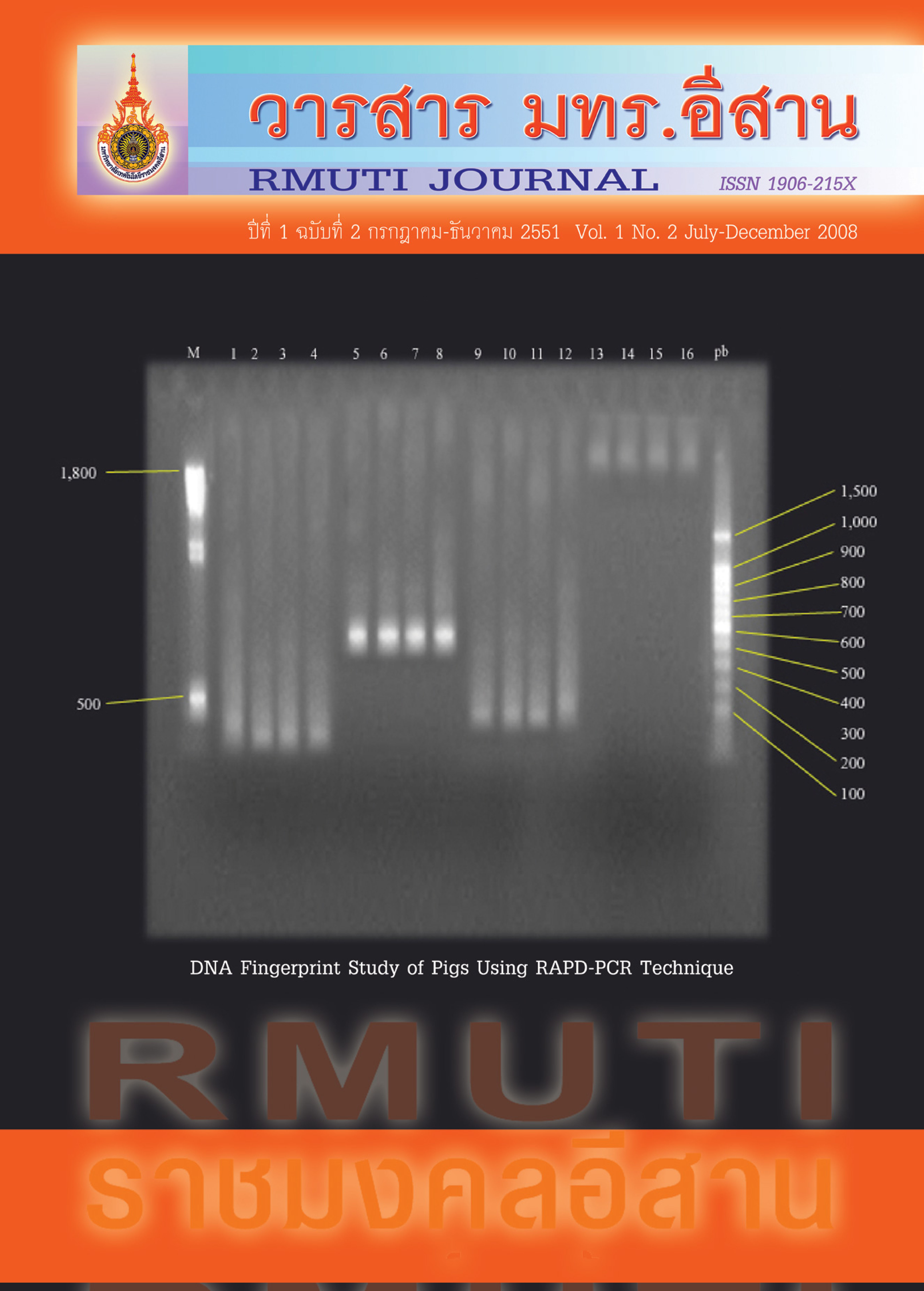ยุทธศาสตร์การบริหารจัดการการสืกษาดนตรื ของสถาบันอุดมศึกษา ในประเทศไทย Management Strategies for the Organization of Music Education in Higher Education Institutions in Thailand
Main Article Content
Abstract
บทคัดย่อ
การวิจัยครั้งนี้ มีจุดมุ่งหมายเพื่อกำหนดยุทธศาสตร์การบริหารจัดการการศึกษาดนตรีของสถาปันอุดม ศึกษาในประเทศไทย ด้านการบริหารจัดการ หลักสูตร บุคลากร ผู้เรียน ระบบการเรียนการสอน การจัดห้องเรียนดนตรี การวิจัยและงานสร้างสรรค์ แหล่งสารสนเทศ เครื่องดนตรีอุปกรณ์และ เทคโนโลยีดนตรี เพื่อจะนำไปเป็นกรอบนโยบายในการจัดการเรียนการสอนด้านดนตรีของสถาบัน อุดมศึกษาในประเทศไทย เป็นการวิจัยเ?งนโยบาย (policy research) โดยมีวัตถุประสงค์คือ 1) เพื่อศึกษาสภาพปัจจุบัน ปัญหาการบริหารจัดการการศึกษาดนตรีของสถาบันอุดมศึกษาใน ประเทศไทย 2) เพื่อศึกษาความคาดหวังการบริหารจัดการการศึกษาดนตรีของสถาบันอุดมศึกษาใน ประเทศไทย และ 3) เพื่อพัฒนายุทธศาสตร์การบริหารจัดการการศึกษาดนตรีของสถาบันอุดมศึกษา
จ <1
ในประเทศไทย วิธีดำเนินการวิจัยมี 2 ขั้นตอนคือ ขั้นตอนที่ 1 การพัฒนาร่างยุทธศาสตร์การบริหาร จัดการใช้ระเบียบวิธีวิจัยแบบผสม (Mixed methodology) ขั้นตอนที่ 2 การวิเคราะห์ร่างยุทธศาสตร์ การบริหารจัดการ การจัดการศึกษาดนตรีของสถาบันอุดมศึกษา ผลการวิจัยพบว่า
สถาบันอุดมศึกษาที่เปีดสอนปริญญาทางดนตรีที่พบในสถาบันอุดมศึกษาในประเทศไทย มีอยู่ ทั้งสิ้น 37 หน่วยงาน สถานะของหน่วยงานทางดนตรีในระดับอุดมศึกษา พบว่ามีอยู่ 4 ลักษณะ คือ ภาค วิชา, กลุ่มสาขาวิชา, คณะ และวิทยาลัย ลังกํดของหน่วยงานทางดนตรีในระดับอุดมศึกษา พบว่ามีอยู่ 5 ลักษณะ คือ ลังกํดคณะศิลปกรรมศาสตร์ ลังกัดคณะมนุษยศาสตร์และสังคมศาสตร์ สังกัดคณะดนตรี สังกัดวิทยาลัย และสังกัดสถาบัน นโยบายการผลิตบัณฑิตที่พบในสถาบันทางดนตรี พบว่ามีอยู่ 5 ลักษณะ คือ เป็นนักดนตรี ศิลปินอาช่พ / เป็นคร ผ้สอนดนตรี / เป็นนักวิชาการ /เป็นนักธุรกิจและอุตสาหกรรม
<น <น่ 4 4
ดนตรีและเป็นนักแต่งเพลงหลักสูตร หลักสูตรทางดนตรีที่เปิดสอนในสถาปันอุดมศึกษาในประเทศไทย มี 5 ลักษณะ ดังนี้ ดนตรีศึกษา(ค.บ.), ดุรียางคศึลป๋ (ศป.บ.), ดุรียางคศาสตร์ (กศ.บ.), ดุรียางคศาสตร ศึกษา (ศศ.บ.), และดนตรี (ศศ.บ.) บุคลากรที่ทำหน้าที่สอนและบริการในหน่วยงานทางดนตรี พบว่า มีสถานะบุคคลเป็น ข้าราชการ พนักงานวิชาการ อาจารย์อัตราจ้าง ลูกจ้างชั่วคราว ผู้เรียน ในสถาบัน การศึกษาที่จ้ดการเรียนการสอนทางดนตรีส่วนใหญ่เป็นนักศึกษาในระดับปริญญาตรีนอกจากนี้มีผู้เรียน ในระดับบัณฑิตศึกษา และมีเพียง 2 แห่งเท่านั้นที่มีผู้เรียนทางดนตรีตั้งแต่ระดับมัธยมศึกษาตอนปลาย ระบบการเรียนการสอน พบว่า ระบบการสอนมีอยู่ 2 ระบบ คือ ระบบปกติเรียนวันจันทร์-ศุกร์ และ ระบบพิเศษเรียนวันเสาร์-อาทิตย์ การจัดห้องเรียนดนตรี พบว่า การจัดห้องเรียนบรรยายมีสภาพที่ สามารถตอบสนองการเรียนการสอนทางดนตรีได้ แต่ส่วนใหญ่การจัดห้องเรียนด้านปฏิบัติยังขาด ประสิทธิภาพ เช่น ขาดห้องเรียนเฉพาะบุคคล ขาดห้องซ้อมรวมวงขนาดใหญ่ รวมทั้งระบบอำนวย ความสะดวกในห้องเรียนดนตรียังไม,เพียงพอ การวิจัยและงานสร้างสรรค์ พบว่า มีการทำงานวิจัย ค่อนข้างน้อย รวมทั้งการสร้างสรรค์ผลงานทางดนตรีก็เช่นเดียวก้น แหล่งสารสนเทศพบว่า ขาดแคลน ห้องสมุดที่มีวัสดุสารสนเทศทางดนตรี เช่น โน้ตเพลง หนังสือด้านดนตรี รวมทั้งสื่อปัศนวัสดุต่างๆ แต่ ก็มีหลายสถาบันที่พยายามจัดห้องสมุดดนตรี เพื่อสนับสนุนการเรียนการสอนของหน่วยงาน เช่น มหาวิทยาลัยมหิดล มหาวิทยาลัยมหาสารคาม และเครื่องดนตรีอุปกรณ์และเทคโนโลยีดนตรี พบว่า มีเครื่องดนตรีที่ไม,เพียงพอต่อการเรียนการสอน เครื่องดนตรีส่วนใหญ่ขาดคุณภาพ เทคโนโลยีที่นำมาใช้ ในการเรียนดนตรีคือ คอมพิวเตอร์ โดยเน้นใช้เพื่อการจัดทำเอกสารทางดนตรี การประพนธ์เพลง รวมทั้งเพื่อการสืบค้นข้อมูลดนตรีจากอินเทอร์เน็ต
ความคิดเห็นของบุคลากรในหน่วยงานที่จัดการเรียนการสอนด้านดนตรีในสถาบันอุดมศึกษา ต่อสภาพปัจจุบัน ปัญหาการบริหารจัดการการศึกษาดนตรีของสถานบันอุดมศึกษาในประเทศไทย โดยจำแนกเป็นรายด้าน พบว่า ด้านที่มีปัญหามาก มี 4 ด้าน ได้แก่ ด้านเครื่องดนตรีอุปกรณ์และ เทคโนโลยีดนตรี ด้านการจัดห้องเรียนดนตรี ด้านการบริหารการจัดการ และด้านแหล่งสารสนเทศ ส่วนด้านที่มีปัญหาปานกลาง มี 5 ด้าน ได้แก ด้านผู้เรียน ด้านงานวิจัยและงานสร้างสรรค์ด้านบุคลากร ด้านหลักสูตร และด้านระบบการเรียนการสอน
คำสำคัญ: การบริหารจัดการ; การศึกษาดนตรี; ยุทธศาสตร์สถาบันอุดมศึกษา
Abstract
This research aimed to determine management strategies for the organization of music education in higher education institutions in Thailand in the following aspects: management, curriculum, personnel, learners, teaching and learning system, music room arrangement, research and innovation, information sources, music instruments, equipment and music technology. This is for proposing of management of music education in higher education institutions in Thailand. It is a policy research with three objectives:
1) To study the current situation, problems, and management of method music education programs in higher education institutions in Thailand. 2) To study the expectation that exist in management music education. 3) To develop management strategies for the organization of music education in higher education institutions in Thailand. The research was done in 2 steps; the first step is a development of management strategies by mixed methodology and the second step is a draft analysis of management strategies for the organization of music education in higher education institutions in Thailand.
The results of the study were as follows:
There are 37 higher education institutions with music degree programs classified by status of musical educated units into 4 catagories: department, program, faculty and college. There are 5 types of authorities; faculty of arts, faculties of human and social science, faculty of music, college and institution. There are 5 types of music graduates in higher education institutions: professional musician, music teacher, personal in music business, music academic and industy and music composer
There are 5 types of curriculum that have been taught in higher education institution in Thailand; music study (B.Ed), musical arts (B.A.), musical science (B.Sc), musical science study(B.A.) and music (B.A.). There are 4 gruops of personnel on the teading staff and service staff: goverment officer, academic staff, contracted tutor and temporary staff. There are 3 groups of music student: Undergraduate student, posh-graduate-student and high school student. There are 2 institutions that officer music courese for high school students.
There are 2 types of education systems: regular system (Monday-Friday) and extra system (Saturday-Sunday). For the musical classroom arrangment, if was found that the classroom can respond to theoritical music teaching and leaning but the music lab is inefficient; eg lack of music learning rooms for individuals, lack of music practice rooms for large bands and lack of facilities in the classroom. In terms of research and innovation, it wad found that there is insufficient music research and little creativity. For the music information sources, There is a lack of music libaries with proper notes, books and visual aids. However, there are some institutions that have set up music libraries to support teaching and learning such as Mahidal University and Mahasarakarm University for musical instruments and music technology, there is an insufficient supply and the quality is low. The computer is the main teachnology used for making up music documents, composing music and searching for information and the Internet.
The opinion of personnel towards the problem in management of music education can be classified into (1) serious problems: musical in students and music technology, classroom arrangement management and sources of information and (2) modorate problems: student, research and creative, personnel, curriemlum, teaching and learning system.
Keywords: Management; Strategies; Music Education; Higher Education


